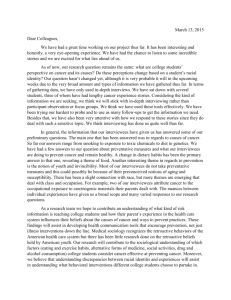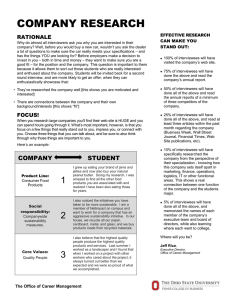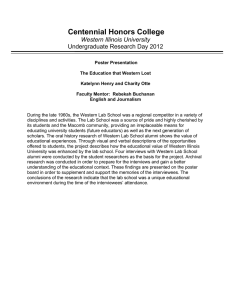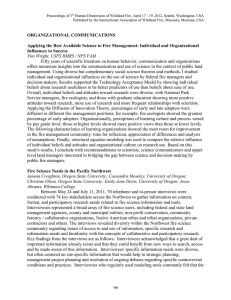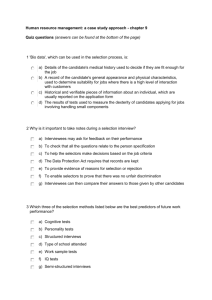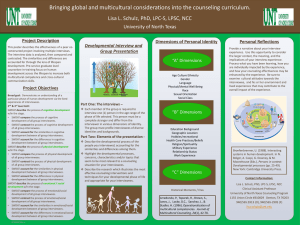THE LONG-TERM IMPACT OF DEBT ADVICE ON LOW INCOME HOUSEHOLDS
advertisement
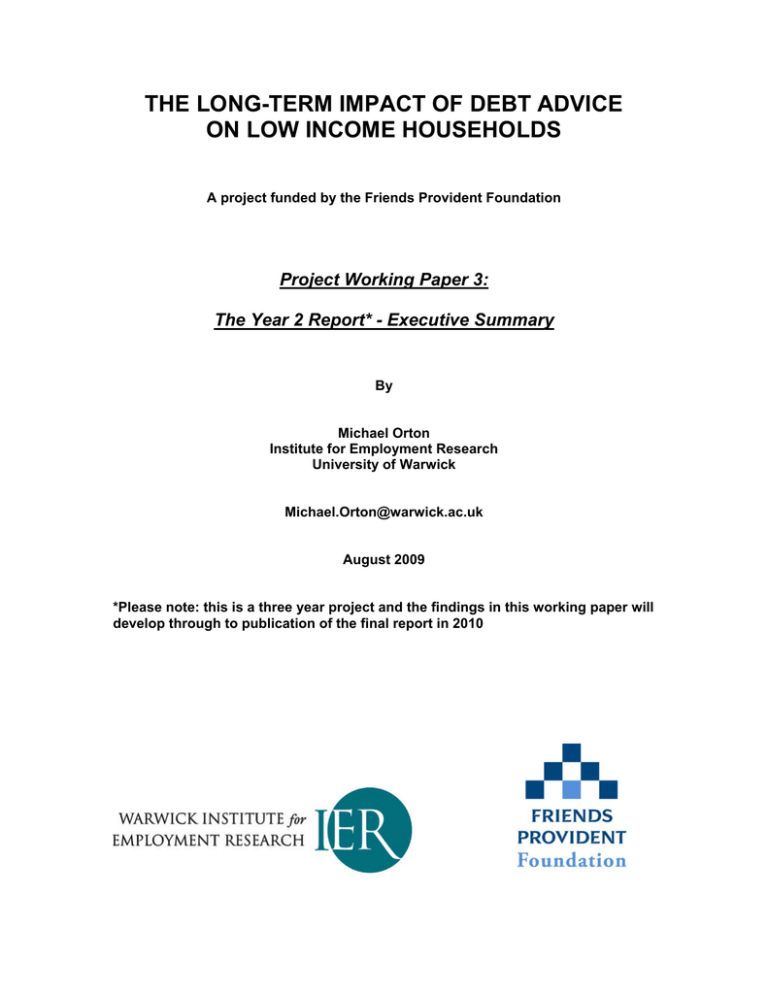
THE LONG-TERM IMPACT OF DEBT ADVICE ON LOW INCOME HOUSEHOLDS A project funded by the Friends Provident Foundation Project Working Paper 3: The Year 2 Report* - Executive Summary By Michael Orton Institute for Employment Research University of Warwick Michael.Orton@warwick.ac.uk August 2009 *Please note: this is a three year project and the findings in this working paper will develop through to publication of the final report in 2010 Executive summary This report presents findings from Year 2 of a qualitative longitudinal study of the impact of debt advice on low income households, based on in-depth interviews with people who have received debt advice and following them up over a three year period. In Year 1, interviews were conducted with 59 people who had received debt advice. In Year 2, 56 interviewees were successfully contacted and re-interviewed – this report is based on findings from those 56 interviews. The key focus of the report is: • ‘debt trajectories’ since Year 1 i.e. whether interviewees said their position had improved, stayed the same, or deteriorated; and, • the impact of advice on those trajectories. From the outset two points need to be emphasised: • the analysis of change is based on interviewees’ perception of their situation. In describing change, indebtedness was a central factor but not the only one – it will be seen that even being debt free did not mean interviewees automatically reported a positive trajectory. Interviewees raised two other key themes: ‘money management’ with this including issues around financial organisation, budgeting, credit use and going without; and income, with this relating to making ends meet on a day to day basis; • advice continued to be seen very positively by interviewees, including having long-term impact, but the research found only a very small number of examples of a neat linear pattern of ‘indebtedness – advice - debt free’; for most interviewees, the situation was far more complex. Chapter 1 - Introduction: the research and the policy context Since commencement of the project there has been a remarkable change in the economy, with the rapid downturn meaning debt has become an issue of immense contemporary importance. Debt advice in this project refers to the free provision of advice for people with debts, by not for profit organisations. Recent research for the Friends Provident Foundation (Gillespie and Dobbie, 2009) estimated that there are approaching 1,500 organisations in the not-for-profit sector providing free-to-client independent debt advice, and advising 1.1 million clients per year. There are indications of growing demand for advice. 2 However, the evidence base regarding the impact of debt advice is small, and ambiguous. This project is original in taking a longitudinal approach over a three year period, and placing emphasis on the experience of low income households. The Year 1 report highlighted a number of key themes around: the causes of debt; the impact of debt on people’s well-being; creditor behaviour; advice seeking behaviour; and the experiences of debt advice. In Year 2, 56 of the original 59 interviewees were successfully contacted and reinterviewed (a re-contact rate of 95%). Chapter 2 – Positive trajectories Just over half of interviewees, 30 out of 56, said their position had improved during the last year but there was a distinction between interviewees who were wholly positive and those who reported more cautious improvement. The first issue raised by interviewees reporting wholly positive improvement related directly to indebtedness, with interviewees either being debt free or in some form of agreed repayments: making a debt problem manageable appears to be as important as being debt free. The second theme raised by interviewees reporting a wholly positive trajectory was ‘money management’ with this including financial organisation, reverting to cash budgeting, a rejection of credit and also accepting a willingness to go without in order to avoid debt, constantly budgeting and weighing every decision on spending. Increased income was a factor across virtually all those reporting positive change; for the large majority of these interviewees increased income was not in itself sufficient to create a positive trajectory, but it contributed to a sense of improvement in particular in helping make ends meet on a day to day basis. The difference between interviewees who reported more cautious improvement and those who were wholly positive was not that a different factor, or set of factors was evident: rather, these interviewees reported improvement in one or even two of the key dimensions – indebtedness, ‘money management’ and income – but a problem still remained with at least one of these factors. Much of the improvement reported by interviewees leaves them far from being debt free, and there is certainly some sense of fragility about improvement; there is greater evidence of ‘financial conservatism’ than the emergence of confident consumers. 3 Chapter 3 - The impact of debt advice on positive trajectories Interviewees who reported positive change were almost equally split between those who saw positive change as directly attributable to advice, and those who saw advice as being partly responsible for improvement. Interviewees who reported cautious improvement rather than wholly positive change could still see advice as having had a direct impact on improvement that had been made. For those who saw advice as being partly responsible for improvement, themes included advice as having had direct impact in helping them move forward, but not perhaps in resolving debts directly; a further element was where advice resolved some debt problems but not all. As in Year 1, there was a very broad range of elements of advice that interviewees saw as having had a positive impact including having had someone to talk to, practical information and representation. Interviewees who reported a positive trajectory also overwhelmingly saw advice as having an on-going, long-term impact based on themes of: advice having moved people forward and continuing to have an impact in promoting a positive trajectory; increased confidence and skills; having practical tools to deal with problems; remembering advice in terms of more general ‘lessons learned’ about credit and money management; and reassurance either in remembering support offered by an advisor, or knowing the advice provider is there if a problem arises. Only 2 of the 30 interviewees who reported positive change said that, despite improvement, advice had not been helpful. Chapter 4 – Neutrality, and the role of advice 17 interviewees reported change in terms of neutrality, either describing their position as being both ‘better and worse’, or ‘the same’; indebtedness, ‘money management’ and income continued to be key themes, but the difficulty of making ends meet on a day to day basis became more evident with this group of interviewees. Interviewees who reported that their position was both better and worse illustrated well the multi-dimensionality of change, but with the key point being either that improvement in indebtedness was not accompanied by an increase in income, and making ends meet remained a major problem; or income had increased but indebtedness remained a problem. Interviewees who said their position was the same were in all but two cases either debt free or making agreed repayments: but none had had an increase in 4 income; some interviewees in this group saw lack of change as positive, particularly meaning that debts were manageable, well-being was satisfactory and, in a phrase used by a number of interviewees, people were ‘getting by’. Other interviewees reporting no change had agreed repayment arrangements to which they were adhering but were more ambiguous about their position, particularly in relation to making ends meet. Despite greater ambiguity about change, views regarding the impact of advice largely reflected those made by interviewees who did report a positive trajectory, as in chapter 3. Key elements of advice were also as in chapter 3: someone to talk to; information and options; and representation. The long-term impact of advice was also evident. However, this group of interviewees also began to demonstrate limits that can be reached in terms of the impact of advice. Chapter 5 - Negative trajectories and the limits of advice 9 interviewees said their financial position was worse than in Year 1, with there being three key issues: income loss; low income and the struggle to make ends meet; and other (non-financial) problems. The first theme related to interviewees (all owner-occupiers) whose debt problems began when they or a partner lost their job; they continued to face serious debt problems, but the central point was a basic lack of income. Lack of money was also emphasised by another group of interviewees, but with their worsening financial position ascribed to the difficulty of making ends meet on a week to week basis. The other two interviewees who reported negative change had rather individual circumstances and raise what could perhaps be seen as an additional dimension of other (non-financial) problems. Interviewees reporting a negative trajectory were still overwhelmingly positive about the advice they had received, but what is evident is the limits of the impact of advice; positive views of advice contained a caveat regarding the limits of advice in addressing the core problems being faced by this group of interviewees. 5 Chapter 6 – Additional themes Negative experiences of creditors, ranging from a sense of creditors as unhelpful and difficult to deal with, through to descriptions of creditors as ‘aggressive’, ‘nasty’ and even ‘bullying’ remained evident. Experience of creditors asking for payment arrangements to be increased, gave interviewees an on-going sense of being under pressure. There were examples of difficulties in negotiating a payment arrangement leading interviewees to decide that trying to deal with a creditor was pointless. In relation to advice seeking behaviour, not seeking further advice can represent both a positive, in that a problem has been resolved and no further help is required, or a negative in that advice has not been seen as helpful. There was some evidence of changed attitudes to seeking advice; Year 3 can continue to examine actual engagement with advice services, and ask specific questions about whether people’s experience of advice has changed their attitude to seeking help whether in relation to debt or other problems more generally. There were a number of additional miscellaneous themes regarding advice seeking, but each applied to very small numbers of interviewees. With regard to financial confidence and engagement with financial education the dominant theme, as in Year 1, was of interviewees seeing this as irrelevant to their experience and circumstances. As in Year 1, for the overwhelming majority of interviewees trying to save money was a complete impossibility; there remained no examples of interviewees having a separate savings account into which they made regular payments. The report includes three appendices: the Year 2 topic guide; the methodology and the sample; and low income. 6

